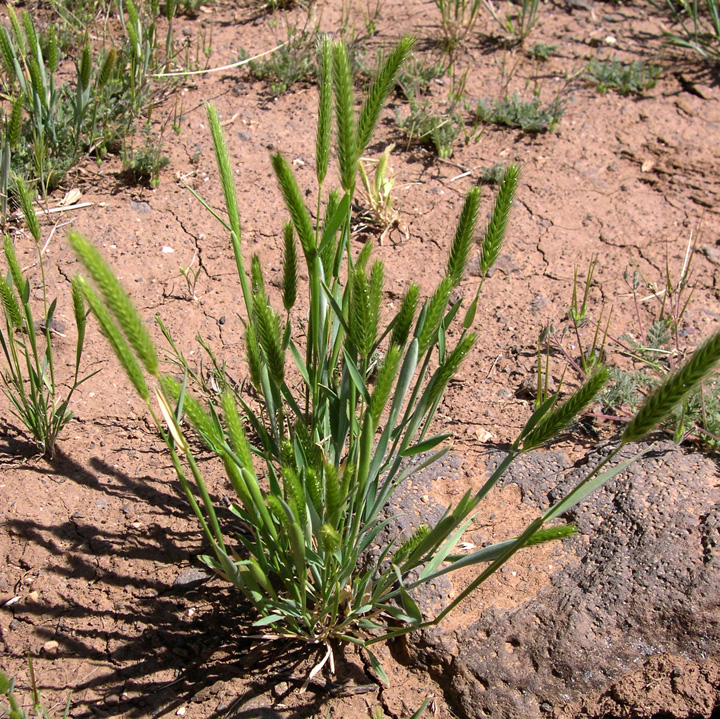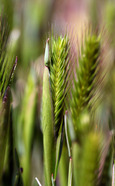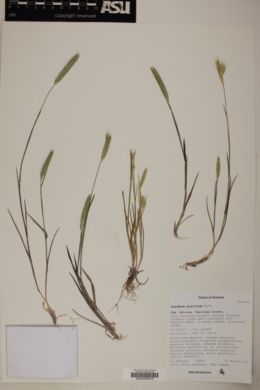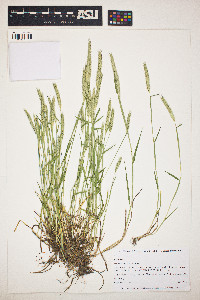|
|
|
|
Family: Poaceae
bobtail barley, more...little barley
[Critesion pusillum (Nutt.) Á.Löve, moreHordeum intercedens Nevski, Hordeum pusillum var. pubens Hitchc.] |
Plants annual; loosely tufted. Culms 5-40 cm, erect to geniculate; nodes usually pubescent. Sheaths with stripes of hairs; ligules 0.3-0.8 mm; auricles usually absent, shorter than 2 mm if present; blades to 9 cm long, to 4 mm wide, both surfaces sparsely to densely hairy, hairs spreading. Spikes 2.5-6.2 cm long, 4-6 mm wide, often partially enclosed at maturity, pale green. Glumes straight, usually slightly divergent at maturity. Central spikelets: glumes to 17 mm long, to 0.8 mm wide basally, distinctly flattened near the base; lemmas 4.5-7.5 mm, usually sparsely pubescent towards the base, glabrous distally, awned, awns 5.6-9.8 mm, often slightly divergent at maturity; anthers 0.6-1.2 mm. Lateral spikelets usually sterile; glumes to 17.5 mm, distinctly flattened near the base; lemmas 1.7-4.4 mm, blunt to acute, usually unawned, rarely awned, awns to 1.2 mm. 2n = 14. Hordeum intercedens grows in vernal pools and flooded, often saline river beds and alkaline flats. It is restricted to southwestern California, including some of the coastal islands, and northwestern Baja California, Mexico. Annual to 4(-6) dm; lvs flat, 2-4 mm wide, erect, without auricles; spikes 2-7 cm (excl. awns), erect; central spikelet sessile, the lateral on curved pedicels 0.3-0.7(-1) mm, their florets reduced, awn-tipped, and borne on curved rachilla-joints ca 0.5 mm; glumes 7-12(-15) mm, those of the central spikelet and the inner glumes of the lateral spikelets slightly to conspicuously broadened above the base before narrowing into slender awns, the outermost glumes wholly awn-like and somewhat shorter, scabrous to puberulent; fertile lemma 5-7 mm, scabrous, faintly 5-veined, tapering into a short awn (4-)5-8 mm; anthers 0.5-0.8 mm; 2n=14. Native weed of pastures, roadsides, and moderately moist waste places; Del. to Fla., w. to Wash., Calif., and n. Mex., and casually intr. n. to Me., Mich., and Minn.; s. S. Amer. Gleason, Henry A. & Cronquist, Arthur J. 1991. Manual of vascular plants of northeastern United States and adjacent Canada. lxxv + 910 pp. ©The New York Botanical Garden. All rights reserved. Used by permission. FNA 2003, Gould 1980 Common Name: little barley Duration: Annual Nativity: Native Lifeform: Graminoid General: Loosely tufted annual grass with erect stems mostly 15-40 cm tall. Vegetative: Blades 2-5 mm wide, 2-10 cm long, flat to u-shaped, scabrous; sheath open, glabrous to short pubescent, with or without small auricles; ligule membranous, truncate, almost entire, less than 0.5 mm long. Inflorescence: Dense spicate raceme, 4-8 cm long, with 3 spikelets per node; outer glumes of the lateral spikelets awnlike, without expanded bodies; other glumes broadened and flattened above the base, scabrous, with awns 7-12 mm long; florets of lateral spikelets irregularly reduced, usually pediceled above the glumes, about half to one-third as large as fertile floret of the central spikelet; lemma of central floret 4-6 mm long with an awn 2-7 mm long. Ecology: Found on roadsides and disturbed soils below 6,000 ft (1829 m); flowers May-August. Distribution: Throughout the US; BC and AB in w. CAN; and n. MEX. Notes: The most widespread native in the genus; a compact, upright annual with blunt spikelets. Awns are shorter than the awns of other Hordeums (12 mm or less). H. brachyantherum has similarly short awns, but that species is a large perennial up to 1 m tall. Ethnobotany: Archeological evidence shows this species was cultivated by multiple tribes in North America thousands of years ago. Etymology: Hordeum is the Latin name for barley; pusillum means small, weak, or insignificant. Synonyms: Critesion pusillum, H. pusillum var. pubens Editor: SBuckley 2010, AHazelton 2015 |





